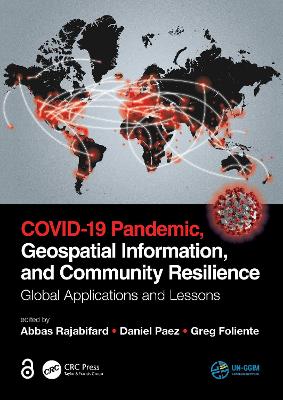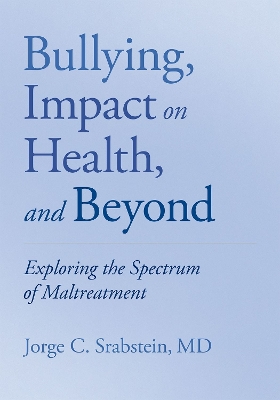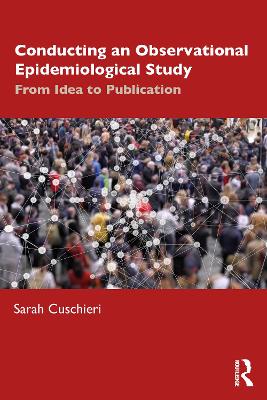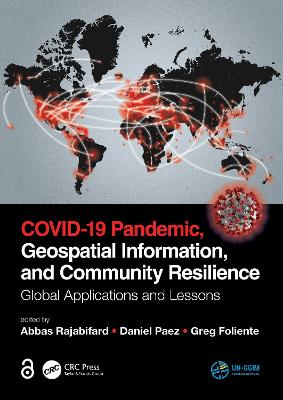COVID-19 Pandemic, Geospatial Information, and Community Resilience
 portes grátis
portes grátis
COVID-19 Pandemic, Geospatial Information, and Community Resilience
Global Applications and Lessons
Rajabifard, Abbas; Foliente, Greg; Paez, Daniel
Taylor & Francis Ltd
05/2024
558
Mole
9781032020457
15 a 20 dias
Descrição não disponível.
Part I: Setting the Scene. The Role and Value of Geospatial Information and Technology in a Pandemic. Part II: Technical and Techno-Social Solutions. Land Administration and Authoritative Geospatial Information: Lessons from Disasters to Support Building Resilience to Pandemics. Open Geospatial Data for Responding to the COVID-19 Challenge. Remote Sensing and Computational Epidemiology. The Potential of Drone Technology in Pandemics. The Role of Neighborhood Social and Built Environments on Social Interactions and Community Wellbeing Through the COVID-19 Pandemic. Social Vulnerability to COVID-19: Preliminary Indicators and Research Agenda. Informal Road Detection and Uncertainty in Remote Sensing. Management and Analysis of Maritime Geospatial Data During COVID-19: Case Studies, Opportunities and Challenges. City Design and the Transmission of COVID-19. Sensing Community Resilience Using Social Media. Role of the Professional Body in a Pandemic. OpenStreetMap Data Use Cases During the Early Months of the COVID-19 Pandemic. Utilization of Geospatial Network Analysis Technique for Optimal Route Planning During COVID-19 Pandemic. Formalizing Informal Settlements to Empower Residents Against COVID-19 and Other Disasters. Spatially Enabled COVID-19: A Review of Applications and Systems. COVID-19 Spatiotemporal Hotspots and Prediction Based on Wavelet and Neural Network. Part III: Regional, Country and Local Applications. London in Lockdown: Mobility in the Pandemic City. Americas' Geospatial Response to COVID-19. Temporal Information Management to Control the COVID-19 Epidemic: Country Perspectives in Europe. Practicing Online Higher Education Facilitated by ICT In China: In The Context Of COVID-19 Pandemic. Time-Series Analysis of COVID-19 in Iran: A Remote Sensing Perspective. "Creating a Set of High-Resolution Vulnerability Indicators to Support the Disaster Management Response to the COVID-19 Pandemic in South Africa". Rapid Development of Location-based Apps: Saving Lives during a Pandemic - the South Korean Experience. Spatial Analysis of Urban Parks and COVID-19: City of Whittlesea, Victoria, Australia. The Economic Impact of COVID-19 in Pacific Island Countries and Territories. Promoting Resilience While Mitigating Disease Transmission: An Australian COVID-19 Study. Impacts of COVID-19 lockdown restrictions on housing and public space use and adaptation: Urban proximity, public health, and vulnerability in three Latin American cities. Use of Geospatial Information and Technologies in Understanding the COVID-19 Pandemic in Canada: Examples and Critical Discussion. Geospatial Intelligence in Dealing with COVID-19 Challenges in Czechia. COVID-19 in France: A Multiphase and Multidimensional Approach to a Complex Societal Imbalance. Part IV: Stakeholder Perspectives. Digital Earth: A World Infrastructure for Sustaining Resilience in Complex Pandemic Scenarios. COVID-19: The Open Data Pandemic. The Challenge of Mapping COVID-19 Data. Better Engagement to Build Smarter, Resilient Communities. How the Coronavirus Could Change Urban Planning. Toward Agile Strategies for Enhancing Community Resilience Following the COVID-19 Pandemic: An Interview Study. COVID-19 Pandemic in Finland: Converting a Forced Digitalisation into an Opportunity. What's the Future of Greek Cities in the Post-COVID-19 Period? New Perspectives on Urban Resilience and Sustainable Mobility. COVID-19 Pandemic Challenges and Impacts on the SDGs 2030: Indian Perspective. The Value of a Policy-Responsive Research Funding Model: The Geohealth Laboratory Collaboration in New Zealand. Pandemic and the City: A Melbourne Perspective for Community Resilience. Spatial Modelling Concepts for Controlling COVID-19 Risk in Saudi Arabia. COVID-19 in Spain and the Use of Geospatial Information. Lessons Learned from COVIDSafe: Understanding Conditions for Successful Implementation of Track and Trace Technologies. Sustainable Transport as a Key Pillar to Community Resilience During the COVID-19 Pandemic. Part V: The Future Direction. Preparing for the next pandemic: Geospatial information for enhanced community resilience.
Este título pertence ao(s) assunto(s) indicados(s). Para ver outros títulos clique no assunto desejado.
Geoinformation;Urban Planning;Geospatial Planning;Public health;sustainable development;disaster management;Spatial Sciences Institute;Global Geospatial Information Management;High Density Road Networks;MERS;Smart Phones;UNECE Region;VRP.;Public Administrations;Geospatial Information;SDG.;Contact Tracing;OpenStreetMap Data;Interactive Web Map;National SDIs;Geospatial Data;Stringency Index;Aged Care Facilities;Mann Kendall Test;VRP;Flipped Classroom;SDG Target;Planetary Boundary Layer Height;Solomon Islands;OSM Database;International Monetary Fund
Part I: Setting the Scene. The Role and Value of Geospatial Information and Technology in a Pandemic. Part II: Technical and Techno-Social Solutions. Land Administration and Authoritative Geospatial Information: Lessons from Disasters to Support Building Resilience to Pandemics. Open Geospatial Data for Responding to the COVID-19 Challenge. Remote Sensing and Computational Epidemiology. The Potential of Drone Technology in Pandemics. The Role of Neighborhood Social and Built Environments on Social Interactions and Community Wellbeing Through the COVID-19 Pandemic. Social Vulnerability to COVID-19: Preliminary Indicators and Research Agenda. Informal Road Detection and Uncertainty in Remote Sensing. Management and Analysis of Maritime Geospatial Data During COVID-19: Case Studies, Opportunities and Challenges. City Design and the Transmission of COVID-19. Sensing Community Resilience Using Social Media. Role of the Professional Body in a Pandemic. OpenStreetMap Data Use Cases During the Early Months of the COVID-19 Pandemic. Utilization of Geospatial Network Analysis Technique for Optimal Route Planning During COVID-19 Pandemic. Formalizing Informal Settlements to Empower Residents Against COVID-19 and Other Disasters. Spatially Enabled COVID-19: A Review of Applications and Systems. COVID-19 Spatiotemporal Hotspots and Prediction Based on Wavelet and Neural Network. Part III: Regional, Country and Local Applications. London in Lockdown: Mobility in the Pandemic City. Americas' Geospatial Response to COVID-19. Temporal Information Management to Control the COVID-19 Epidemic: Country Perspectives in Europe. Practicing Online Higher Education Facilitated by ICT In China: In The Context Of COVID-19 Pandemic. Time-Series Analysis of COVID-19 in Iran: A Remote Sensing Perspective. "Creating a Set of High-Resolution Vulnerability Indicators to Support the Disaster Management Response to the COVID-19 Pandemic in South Africa". Rapid Development of Location-based Apps: Saving Lives during a Pandemic - the South Korean Experience. Spatial Analysis of Urban Parks and COVID-19: City of Whittlesea, Victoria, Australia. The Economic Impact of COVID-19 in Pacific Island Countries and Territories. Promoting Resilience While Mitigating Disease Transmission: An Australian COVID-19 Study. Impacts of COVID-19 lockdown restrictions on housing and public space use and adaptation: Urban proximity, public health, and vulnerability in three Latin American cities. Use of Geospatial Information and Technologies in Understanding the COVID-19 Pandemic in Canada: Examples and Critical Discussion. Geospatial Intelligence in Dealing with COVID-19 Challenges in Czechia. COVID-19 in France: A Multiphase and Multidimensional Approach to a Complex Societal Imbalance. Part IV: Stakeholder Perspectives. Digital Earth: A World Infrastructure for Sustaining Resilience in Complex Pandemic Scenarios. COVID-19: The Open Data Pandemic. The Challenge of Mapping COVID-19 Data. Better Engagement to Build Smarter, Resilient Communities. How the Coronavirus Could Change Urban Planning. Toward Agile Strategies for Enhancing Community Resilience Following the COVID-19 Pandemic: An Interview Study. COVID-19 Pandemic in Finland: Converting a Forced Digitalisation into an Opportunity. What's the Future of Greek Cities in the Post-COVID-19 Period? New Perspectives on Urban Resilience and Sustainable Mobility. COVID-19 Pandemic Challenges and Impacts on the SDGs 2030: Indian Perspective. The Value of a Policy-Responsive Research Funding Model: The Geohealth Laboratory Collaboration in New Zealand. Pandemic and the City: A Melbourne Perspective for Community Resilience. Spatial Modelling Concepts for Controlling COVID-19 Risk in Saudi Arabia. COVID-19 in Spain and the Use of Geospatial Information. Lessons Learned from COVIDSafe: Understanding Conditions for Successful Implementation of Track and Trace Technologies. Sustainable Transport as a Key Pillar to Community Resilience During the COVID-19 Pandemic. Part V: The Future Direction. Preparing for the next pandemic: Geospatial information for enhanced community resilience.
Este título pertence ao(s) assunto(s) indicados(s). Para ver outros títulos clique no assunto desejado.
Geoinformation;Urban Planning;Geospatial Planning;Public health;sustainable development;disaster management;Spatial Sciences Institute;Global Geospatial Information Management;High Density Road Networks;MERS;Smart Phones;UNECE Region;VRP.;Public Administrations;Geospatial Information;SDG.;Contact Tracing;OpenStreetMap Data;Interactive Web Map;National SDIs;Geospatial Data;Stringency Index;Aged Care Facilities;Mann Kendall Test;VRP;Flipped Classroom;SDG Target;Planetary Boundary Layer Height;Solomon Islands;OSM Database;International Monetary Fund







